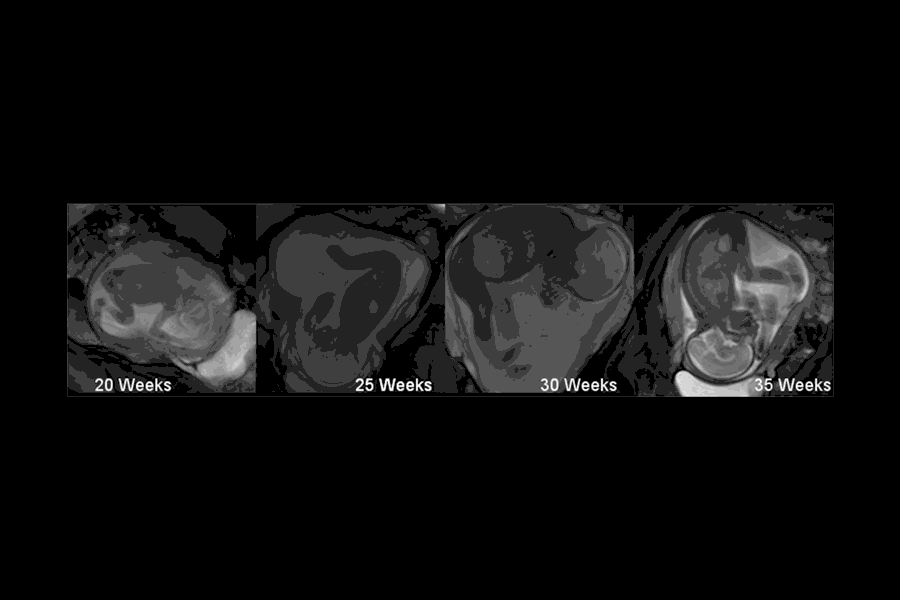Why Does My Baby Nuzzle Her Head Into Me
Why Do Babies Kick in the Womb?

The starting time time a meaning adult female feels her baby kick tin can be surprising — a sudden reminder that the tiny creature growing inside her has a mind of its own. But why practice babies kicking?
Though the womb is a tight space in which to exercise, it turns out that those kicks are vital for the babe'southward good for you bone and joint development, an expert told Alive Science.
Fetuses begin moving in the womb about as early on equally seven weeks, when they slowly bend their necks, co-ordinate to a review paper published in the periodical Ultrasound in Obstetrics & Gynecology. As the babies abound, they gradually add together more movements to their repertoire, such every bit hiccupping, arm and leg movements, stretching, yawning, and thumb sucking. Simply the mom won't feel the bigger movements — such as kicks and punches — until 16 to 18 weeks into her pregnancy, when the baby is a fleck stronger. [In Photos: How Babies Larn]
Babies need their do, also
An entire field of research is dedicated to figuring out whether the baby is in command of its movement or if those movements are just a reflex, said Niamh Nowlan, a bioengineer at Royal College London. "Early movements are likely to exist purely reflex," Nowlan told Live Science in an email, just equally the movements become more coordinated, "it's likely the encephalon is in control of how much and when the babe moves." (Reflexes, on the other hand, come from the spinal cord and don't require input from the brain.)
Scientists may not know for sure if the movements are voluntary or involuntary, but Nowlan said the research is articulate that movement is of import. "The babe needs to motion [in the womb] to be good for you after birth, particularly for their bones and joints," she said. In a review she published in the journal European Cells and Materials, Nowlan described how a lack of fetal motility tin can lead to a variety of congenital disorders, such as shortened joints and thin bones that are susceptible to fracture.
For pregnant women wondering if their infant is besides kicky, or not kicky enough, Nowlan said there'southward no established amount of normal fetal movement during pregnancy. "Pregnant women are told to look out for significant changes in movements, which is quite vague advice, but it's the all-time that tin be given at the moment," she said.
That's because it's difficult for scientists to study fetal movements, because the only way to measure them is in the hospital and it can be done for only a short period at a fourth dimension. To get effectually this problem, Nowlan and her colleagues are working on developing a fetal-movement monitor that the mother can wear during her normal daily activities. The researchers tested the monitor on 44 women who were 24 to 34 weeks pregnant and could accurately observe breathing, startle movements and other full general body movements. Their results were published in the periodical PLOS One in May.
One study, published in 2001 in the journal Human being Fetal and Neonatal Movement Patterns, constitute that boys may motion around more in the womb than girls. The average number of leg movements was much college in the boys compared to the girls at twenty, 34 and 37 weeks, that study constitute. But the report'southward sample size was small, only 37 babies, so Nowlan and her colleagues are hesitant to merits there'south a relationship betwixt gender and fetal motion.
Fetal kicks can pack a punch
It's unlikely that each woman will feel the same thing when her baby starts kicking.
"Different women experience the sensation quite differently, and sensations tin can vary between pregnancies," Nowlan said. In her own 2 pregnancies, for example, she said she was much more sensitive to the movements of her second child compared to those of her first. "I could e'er tell where my son'due south feet were, whereas that wasn't actually the instance for my kickoff," she said. She hypothesized that this variation could have arisen because the womb muscles are more than stretched out later on the showtime pregnancy, a topic she's now studying.
The most-pronounced movements mothers will feel are the baby'due south kicks. A recent study from Nowlan and her colleagues, published in the Periodical of the Royal Club Interface in January, plant that the bear on of the baby'southward boot increases from half-dozen lbs. (2 kilograms) of force at 20 weeks to 10 lbs. (4 kg) of force at 30 weeks. After that point, the baby's kick strength decreases to just under 4 lbs. (2 kg). The scientists said they suspect the decrease in movement occurs because in that location is less room for the baby to move around.
But babies in the womb are doing more than just kicking. By xv weeks, the baby is too punching, opening and closing its oral fissure, moving its head, and sucking its thumb. A few weeks later, the babe will open up and shut its optics. But the mother will feel only the major movements: kicking, punching and peradventure large hiccups.
The babies besides do "animate movements,'" said Nowlan. While the baby isn't actually animate air, it volition perform the same movement, only with amniotic fluid. Nowlan explained that babies who don't perform this movement frequently have trouble breathing once they're born, considering they haven't built up their chest muscles.
Feeling a baby moving and kicking in the womb might be a weird sensation, only it's simply a sign of good for you evolution.
Original article on Live Science.
Source: https://www.livescience.com/62928-why-babies-kick.html

0 Response to "Why Does My Baby Nuzzle Her Head Into Me"
Enregistrer un commentaire